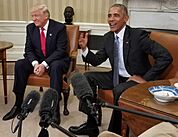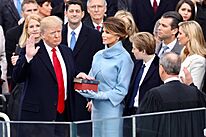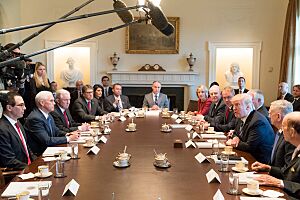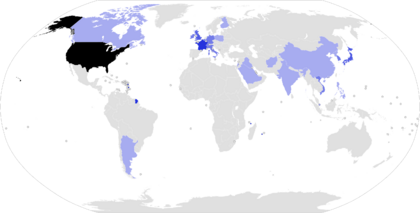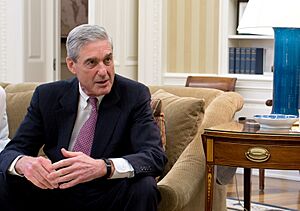First presidency of Donald Trump facts for kids
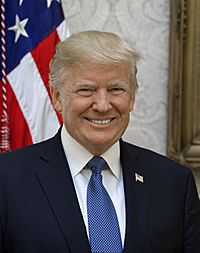 |
|
Quick facts for kids
First presidency of Donald Trump
|
|
|---|---|
| January 20, 2017 – January 20, 2021 | |
| Mike Pence | |
| Cabinet | Full list |
| Party | Republican |
| Election | 2016 |
| Seat | White House |
|
← Barack Obama • Joe Biden →
|
|
Donald Trump's first term as the 45th president of the United States began on January 20, 2017, and ended on January 20, 2021.
Trump was a member of the Republican Party and a businessman from New York. He won the 2016 presidential election against the Democratic candidate, Hillary Clinton. When he took office, he was the first president who had not served in the military or held a government position before. During his presidency, many fact-checkers said that he made many statements that were not accurate.
When Trump became president, the Republican Party also controlled both the House of Representatives and the Senate. This is called a government trifecta, which means one party controls the presidency and both houses of Congress.
Some of the major laws Trump signed include the Tax Cuts and Jobs Act of 2017 and the First Step Act, a law about the justice system. He appointed three new justices to the Supreme Court: Neil Gorsuch, Brett Kavanaugh, and Amy Coney Barrett. In foreign policy, he followed a policy of "America First". This included making new trade deals like the United States–Mexico–Canada Agreement (USMCA) and withdrawing the U.S. from the Paris Agreement on climate change.
His presidency ended after he lost the 2020 presidential election to Joe Biden. He later ran for president again and won the 2024 election. He began his second term on January 20, 2025, becoming the 47th president.
The 2016 Election
Donald Trump announced he was running for president in June 2015. He competed against other Republicans to become the party's nominee. By May 2016, he had won enough support to become the Republican candidate. He chose Mike Pence, the governor of Indiana, to be his vice presidential running mate.
The election was held on November 8, 2016. Trump's main opponent was the Democratic nominee, Hillary Clinton. Although Clinton received almost 2.9 million more individual votes across the country (the popular vote), Trump won the election.
This happened because the U.S. uses a system called the Electoral College. In this system, each state gets a certain number of "electoral votes." A candidate needs to win at least 270 of these votes to become president. Trump won 304 electoral votes, while Clinton won 227. He was the fifth president in U.S. history to win the election without winning the popular vote.
First Years in Office
Inauguration
After winning the election, Trump prepared to take office during a time called the presidential transition. He chose the people who would work in his administration and lead various government departments.
Trump was inaugurated on January 20, 2017. He took the oath of office, which was given by Chief Justice John Roberts. In his first speech as president, he promised to put "America First." The next day, the 2017 Women's March, one of the largest protests in U.S. history, took place in opposition to his presidency.
Administration and Cabinet
The group of advisors and heads of government departments that work for the president is called the Cabinet. Trump's first Cabinet included Jeff Sessions as Attorney General, Steve Mnuchin as Treasury Secretary, and James Mattis as Defense Secretary.
During his four years as president, many people in his administration left their jobs and were replaced. This high rate of staff turnover was unusual compared to past presidents.
Key Policies
During his presidency, Trump focused on changing policies related to the economy, the environment, and immigration.
Domestic Policy
One of the biggest laws passed during his term was the Tax Cuts and Jobs Act of 2017. This law lowered taxes for many businesses and individuals. He also tried to repeal the Affordable Care Act, a healthcare law passed under President Obama, but was not successful.
Trump's administration also changed many environmental rules. He withdrew the United States from the Paris Agreement, an international agreement to fight climate change. He also put tariffs (taxes on imported goods) on products from countries like China, which led to a trade war.
One of his major campaign promises was to build a wall on the border between the United States and Mexico. His request for funding for the wall led to the longest government shutdown in U.S. history.
Foreign Policy
Trump's foreign policy was called "America First." This meant he focused on what he believed were the best interests of the United States, sometimes acting without the agreement of traditional allies.
He met with North Korean leader Kim Jong Un three times to discuss North Korea's nuclear weapons program. This was the first time a sitting U.S. president had met with a leader of North Korea.
In the Middle East, his administration helped broker the Abraham Accords. These were agreements that normalized relations between Israel and several Arab nations, including the United Arab Emirates and Bahrain. He also moved the U.S. embassy in Israel to Jerusalem and withdrew the U.S. from the Iran nuclear agreement.
Judicial Appointments
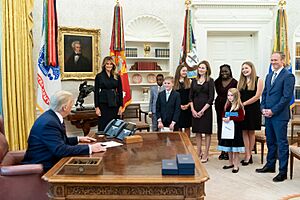
One of a president's most important jobs is to appoint federal judges, who serve for life. Trump appointed over 200 judges to federal courts. His appointments were generally conservative, meaning they often interpret the law in a more traditional way.
Supreme Court
The Supreme Court is the highest court in the country. During his term, Trump appointed three justices to the Supreme Court:
- Neil Gorsuch was appointed in 2017 to fill the seat of Justice Antonin Scalia, who had passed away in 2016.
- Brett Kavanaugh was appointed in 2018 to replace Justice Anthony Kennedy, who retired.
- Amy Coney Barrett was appointed in 2020 after the death of Justice Ruth Bader Ginsburg.
These appointments gave the Supreme Court a strong conservative majority.
Major Events and Challenges
Trump's presidency faced several major investigations and challenges.
Russia Investigation
After the 2016 election, U.S. intelligence agencies concluded that Russia had interfered in the election to help Trump win. A special investigation, led by Robert Mueller, was started to look into this.
The Mueller Report, released in 2019, found that Russia did interfere in the election. However, the report stated that it "did not establish that members of the Trump Campaign conspired or coordinated with the Russian government."
First Impeachment
In 2019, Trump was impeached by the House of Representatives. Impeachment is a process where Congress can formally accuse a president of wrongdoing. The charge was that he had asked the president of Ukraine to investigate his political rival, Joe Biden.
After the House voted to impeach, the Senate held a trial. In February 2020, the Senate voted to acquit him, which means he was found not guilty. He remained in office.
COVID-19 Pandemic
In 2020, the COVID-19 pandemic began. The Trump administration's response included travel restrictions and economic relief packages like the CARES Act. Trump also launched Operation Warp Speed, a government program to help develop and distribute COVID-19 vaccines quickly.
The 2020 Election and End of Term
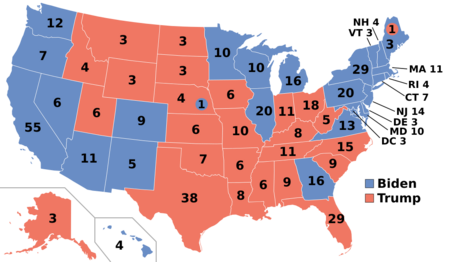
Losing Reelection
Trump ran for a second term in the 2020 election against the Democratic candidate, former Vice President Joe Biden. On November 7, 2020, news organizations projected that Joe Biden had won the election.
After the election, Trump claimed that there had been widespread fraud and that he had actually won. He and his campaign filed many lawsuits to challenge the results, but the courts did not find evidence to support these claims.
Events at the U.S. Capitol
On January 6, 2021, Congress met to officially count the electoral votes and confirm Joe Biden's victory. On the same day, a large crowd of Trump's supporters marched to the Capitol building and entered it. This disrupted the vote count for several hours. Congress later returned and finished counting the votes, officially making Joe Biden the next president.
Second Impeachment
Following the events of January 6, the House of Representatives voted to impeach Trump for a second time. This made him the only president in U.S. history to be impeached twice. The charge was "incitement of insurrection," related to his role in the events at the Capitol.
The Senate held a trial in February 2021, after Trump had already left office. He was acquitted again, as the Senate did not reach the two-thirds vote needed to convict him.
Images for kids
-
During a joint news conference, Trump said he was "very proud" to hear Brazilian president Jair Bolsonaro use the term "fake news."
-
Trump and North Korea's leader Kim Jong Un shake hands at the Korean Demilitarized Zone, June 30, 2019.
-
Trump and Vice President Mike Pence at a welcoming ceremony for military leaders in 2019.
-
From left: National Security Advisor Robert O'Brien, Vice President Mike Pence, President Donald Trump, and military leaders in the White House Situation Room, October 26, 2019.
-
Trump with Turkish president Recep Tayyip Erdoğan, May 16, 2017.
-
Trump with Israeli prime minister Benjamin Netanyahu, February 15, 2017.
See also
- Bibliography of Donald Trump
- Efforts to impeach Donald Trump
- Make America Great Again
- Political positions of Donald Trump
- Timeline of investigations into Trump and Russia



